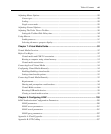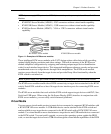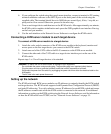
Chapter 1: Product Overview 3
switch. Virtual media can be connected directly to the supported KVM switch using one of the four
USB ports on the switch.
OSD graphical user interface
The KVM switch uses the OSD interface, which has menus to configure the switching system and
select computers. You can list target devices by unique name, eID (electronic ID) or port number.
Security
Use the OSD interface to protect the switching system with a screen saver password. After a
user-defined time, the screen saver mode engages and access is prohibited until the correct
password is entered to reactivate the switching system.
Operation modes
The OSD user interface provides four operation modes for system administration of the KVM
switch. Use these modes (Broadcast, Scan, Switch and Share) to manage the switching activities.
See Chapter 3, “Basic Operations”, beginning on page 16, for more information.
Video
The KVM switch provides optimal resolution for VGA, SVGA, and XGA video. You can achieve
resolutions up to 1280 x 1024.
Flash upgradability
Upgrade the KVM switch at any time through the network port to ensure the KVM switch is always
running the most current available version of firmware.
See “Appendix A” beginning on page 105
for more information.
Web interface
The web interface is launched directly from the KVM switch, and any servers connected to the
KVM switch are automatically detected. You can use the web interface to configure KVM switches
from a web browser. Launch the Viewer from the web interface to establish KVM and virtual
media sessions to target devices.
Authentication and authorization
Depending on how each KVM switch is configured, you can authenticate and authorize users by
using either the KVM switch database or the Lightweight Directory Assistance Protocol (LDAP).
LDAP is a vendor-independent protocol standard used for accessing, querying and updating a
directory using TCP/IP. Based on the X.500 directory services model, LDAP is a global directory
structure that supports strong security features including authentication, privacy, and integrity.
After users log in to a KVM switch, their credentials (user name and password) are cached for the
duration of the session.


















